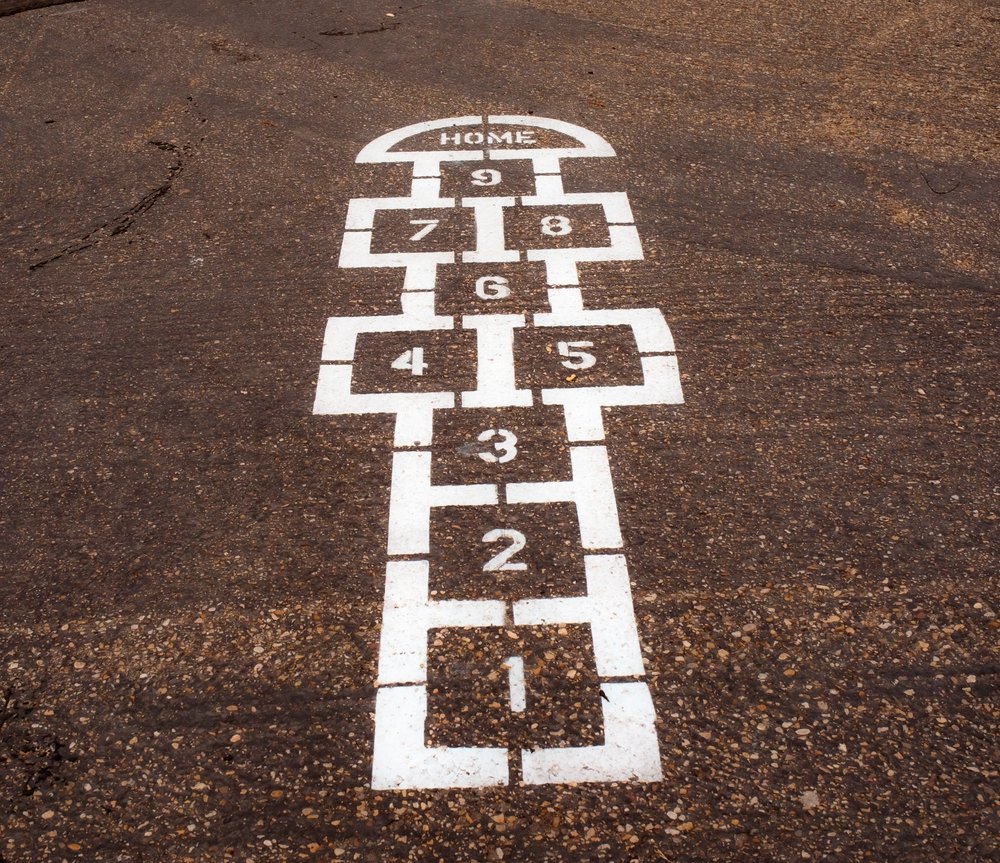Last Updated on January 25, 2024 by Gamesver Team and JC Franco

Playing Hopscotch, for many of us, is a fond childhood memory. Aside from a stone and possibly some chalk, there are no true game pieces. It’s a game that can be played by almost anybody, anyplace. What exactly is Hopscotch?
This favorite childhood game, it turns out, has been played by children throughout the world for hundreds, if not thousands, of years. This fact alone is enough to get you thinking about the history of Hopscotch.
This history of Hopscotch tells us a lot about the game. According to some historians, the ancient Romans had their form of Hopscotch. Soldiers would hop over long distances carrying heavyweights in this version of the game to improve strength and agility. Roman children are supposed to have adopted the game for themselves, resulting in centuries of youthful entertainment.
This little snippet of history is enough to get your attention, isn’t it? Want to learn more about the history of Hopscotch? Read on.
A Brief History of Hopscotch
While you may have played Hopscotch almost blindly following the rules before, you may not have realized that the game is defined by a set of formal rules and court layouts. Indeed, the many variations of Hopscotch games that have been discovered throughout history all share comparable court layouts and basic principles.
Hopscotch court-like pavement designs have been found in ancient Egypt, Greece, and China. They are about 4,000 years old in certain cases. Despite these claims, there is no proof that the game of Hopscotch can be traced back to prehistoric times. The first documented records of what is now known as Hopscotch date back to the 17th century in the English-speaking world.
The game was referred to as “Scotch Hoppers” or “Scotch-hop” in early English sources. Scotch refers to the lines that were drawn to establish the court. Children would hop over the “scotch” marks to retrieve their marker in this version, which is strikingly similar to modern Hopscotch.
Hopscotch in Military Training
It’s believed Hopscotch dates back to the early Roman Empire. Military training drills were conducted on the original Hopscotch courts, which were over 100 feet long. The Roman foot-soldiers raced the course with full armor; they did all these field packs to improve their feet, just as modern football players go over the rows of truck tires today.
In imitation of the soldiers, Roman youngsters drew their miniature courts, adding a scoring system, and “Hopscotch” spread throughout Europe. The word “London” is usually written at the top of Hopscotch courts to evoke the Great North Road, a 400-mile Roman road that connected Glasgow and London and was extensively used by Roman armies.
Hopscotch on the Playground
Hopscotch, as it is commonly known, is a playground game that has entertained children all over the world for years. It is one of the most popular and oldest street/playground games. Before video games, youngsters were captivated by games like Hopscotch, which continues to this day. The game has stood the test of time and continues to entertain children around the world.
The Hopscotch game is played in many different ways around the world. However, almost all other variations follow the same basic rule: the player tosses a small object into numbered slots and then hops through them to retrieve it.
The game’s appeal stems from the fact that it can be played by a group or by a single player. We’ve got all the details on this game that’s been entertaining kids for thousands of years.

Hopscotch Variations Emerged
Hopscotch is a centuries-old game that originated in Ancient Rome. Roman children are reported to have taken inspiration from the soldiers’ pastimes. They used a scaled-down version of the game with a scoring system. The game quickly gained popularity throughout Europe.
The game was first referred to by its name in the 17th century when it was referred to as “Scotch-hop.” The game appears in Poor Robin’s Almanack series for 1677 with the name “Scotch-hoppers.”
To begin the game, you must first sketch out the court. The conventional method is to either draw it with chalk on the road/pavement or etch it out with a stick on dirt/sand. The court is permanently drawn with paint in parts like a school playground.
The Original Game
The original Hopscotch court is made up of 8 or 10 squares laid out in a straight line. “Square 1” is followed in a parallel fashion by “square 2” and “square 3” in the pattern.
Then there’s “square 4,” “square 5,” and “square 6,” all drawn in parallel. The pattern continues with the following squares, with “square 10” serving as the home square. In another form, a square adjacent to square number 10 is designated as the home square.
Many variations of the game use circles or rectangles instead of squares and feature more or fewer squares. The size of the court is usually determined by the players themselves, based on their age. The squares get smaller as the youngsters get smaller, making it easier for them to hop across.
Hopscotch: Gameplay
A marker, generally a common stone, is used by each player. The first player places their marker in the center of the first square. Without bouncing out or touching a line, the marker must land totally within the allotted square. If the player fails to do so, or if the marker lands in the wrong square, the turn is forfeited.
If the toss is successful, the player begins at square one and hops around the court. The left foot lands in the left square, and the right foot lands in the right square, straddling the side of the squares by the side. On one foot, single squares must be hopped into. Either foot can be utilized for the initial single square.
The feet on subsequent single squares must be alternated. Squares labeled “Safe” (or “Home”/”Neutral”/”Rest”/etc.) or “London” are neutral squares that can be jumped through in any order.
When the player gets to the end, they have to turn around and jump across the squares in the opposite direction; they then have to stop along the way to pick up their marker. When the sequence is properly completed, the player resumes their turn by tossing their marker into square two and continuing in the same manner.
If a player steps on a line, misses a square, or loses their balance and falls while hopping, their round is over. They don’t earn credit for finishing the current sequence, and they’ll have to start it over on their next turn. The player who completes one course for each of the court’s numbered squares wins.
Hopscotch Game Rules
- If a player tosses the object into the wrong square in a game with several players, they will lose their turn, and it will be the next person’s turn to play.
- A player loses their turn if they step on the line, enter the wrong square, loses their balance while inside the court, miss a square, or step into a single square with their two feet in.
- If a player loses their chance, they must start over from the same number they stopped at before losing their opportunity on their next turn.
- The game is won by the player who completes the sequence by throwing the object into all of the squares.
Different Variations of Hopscotch
The Hopscotch game is played in many different ways all around the world. We’ve put up a list of entertaining modifications that will make the game much more tough and enjoyable!
- In one of the most popular forms of the game, the object is kicked from one box to the next with the hopping foot.
- In a more difficult variation, after each player completes their sequence, they write their initials on the square they just completed, which then becomes neutral for that player alone. While they take their turn, the other players are expected to skip that tile.
- In another variation, the participants must complete the sequence within a certain amount of time (usually 30 -60 seconds).
Hopscotch Names Around the World

Hopscotch is called various names in different parts of the world; here are a few names you might hear Hopscotch called around the world.
- In some parts of South and Central American countries, it is called Rayuela
- In Brazil, it is called Amarelinha
- In India, it is called it Kith-Kith, Kunte bille, and Ekka Dukka
- In the Glasgow area of Scotland, it’s Peevers
In closing
Hopscotch is a game that may be played on almost any flat surface. Courts can be as simple as a stick-scrawled pattern in the mud to permanent concrete or tile recreational grounds. You can either sketch your court freehand or use one of the many available stencils for a more professional look.
Fortunately, just because it’s raining doesn’t mean you can’t play. Even if you have to stay inside, there are plenty of Hopscotch mats and carpets to keep you hopping. You can just try to get it and enjoy the game, any time of the day.

